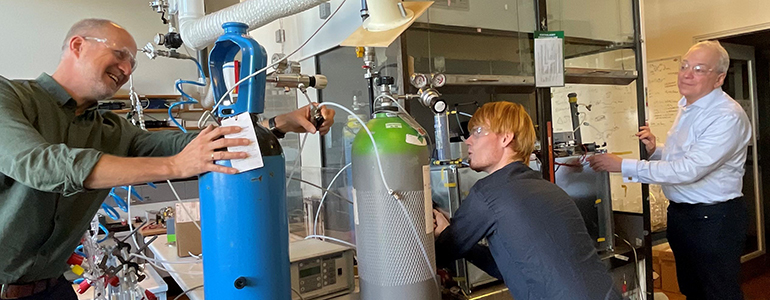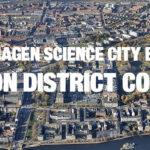Climate entrepreneur in Copenhagen Science City chases capital after research breakthrough
Anyone with an understanding of climate change knows that methane gas is a major climate offender. Anyone with an understanding of gas chemistry knows that methane is extremely difficult to remove when it occurs at low concentrations. Nevertheless, a researcher at Copenhagen Science City-partner, University of Copenhagen, has invented a revolutionary method that removes methane from difficult diffuse sources such leaky biogas production plants. Research published December 2023 in Environmental Research Letters proves that the method could be a gamechanger in the battle against climate change. In order to put the method to work, the researcher has co-founded the company Ambient Carbon. Now the company is looking for investors. By Jes Andersen.
Major cause of climate change
Methane causes about a third of all current greenhouse gas impact on climate. There is very little in the atmosphere, but one ton of methane has the climate impact of 86 tonnes of CO2. The United Nation’s climate change panel IPCC has established, that limiting the emission of methane immediately will minimize the rise in global temperatures.
Translating cutting edge research into novel solutions for global problems goes to the very heart of what our innovation district hopes to achieve”: Kristoffer Klebak, Head of Secretariat, Copenhagen Science City.
The unresponsive climate gas
Atmospheric Chemist Matthew Johnson is an expert on the behaviour of gasses in the atmosphere, and he wanted to combat climate change. But like everyone else, he knew that methane in small concentrations is practically impossible to remove.
Methane behaves like a noble gas. It barely reacts with other gases. It does react with the hydroxyl radical (OH) in the atmosphere, but at a snail’s pace. It takes around 12 years to remove the methane. My breakthrough came when I got an idea for how to accelerate the reaction to make it approximately 100 million times faster”: Matthew Johnson, Professor of Environmental and Atmospheric Chemistry at the University of Copenhagen, and CEO at Ambient Carbon.
Diffuse sources difficult to control
Where the concentration of methane is high, it is easy to remove. You just light a match. The problem arises when methane occurs in low concentrations, such as when it escapes from cow barns or wastewater treatment plants. At these low concentrations you can no longer burn it and it seemed impossible to separate or purify.
58 percent going on 88
The research results Johnson and his team published in the peer-reviewed scientific journal Environmental Research Letters show that his method removes 58 percent of low-concentration methane, but the team has already gone way beyond that. In the latest lab prototype tests, they achieved 88 percent removal efficiency. For the chair of the company Ambient Carbon, these initial results are crucial.
Ambient Carbon is currently raising money to complete development of our field prototype and a full-scale pilot. The first thing potential investors ask us is whether we can prove that our technology works. That’s why a peer-reviewed article published in a reputable scientific journal is crucial for us. It confirms that our method of eradicating low-concentration methane is extremely effective. We will use the funding to hire more staff in order to speed up development so we can get to commercialization by early 2025”: David S. Miller, COO and Chair, Ambient Carbon.
Long journey from lab to shelf
New companies based on basic research usually take a long time to mature. Johnson came upon his idea in 2014, and only in 2017 did he find time to develop it. Researchers at the University of Copenhagen’s Niels Bohr Institute were studying greenhouse gases in Greenlandic ice core samples, and small amounts of methane in the laboratory air were disrupting their measurements. They asked Johnson for advice, and he came up with a small proof of concept device that eradicated 97% of the methane in the airstream. He eventually wrote a description of his invention and filed a patent application in 2020.
It’s easy enough to get ideas, but you always have to spend time and effort developing an idea into something that can benefit society. So in a way ideas are also a nuisance. When you have an idea that can really make a difference, you know that there is a mountain of work waiting”: Matthew Johnson, Professor, University of Copenhagen and CEO, Ambient Carbon.
Field prototype is next step
With the patent in hand, a large and important development task was still pending. Johnson and Miller had to prove that their method could eliminate tons of low-concentration methane. In December 2022, their first prototype was ready for testing, and then things got moving. The first prototype removed five percent on a good day in the lab. The latest prototype consistently removes 70 percent, and now the team is working on a field prototype that takes the method out of the lab to a real methane emitter. The goal for Ambient Carbon is to remove 93% of the methane in the airstream.
We’ve created a company that combats a significant source of climate change. We have done this because climate change is an existential problem. I could have continued to research the problem, but in the business world I can make a bigger difference and do it faster”: Matthew Johnson, Professor, University of Copenhagen and CEO, Ambient Carbon.
First field test at pig barn
At the time of writing, Johnson and his team are waiting for a 40-foot shipping container. When it arrives at the University of Copenhagen’s grounds, they will turn it into a field prototype that they will test in a pig barn. While Johnson and his team of researchers and technicians develop and test ways to make the method even more robust and efficient, COO David Miller works relentlessly to raise capital.
The climate crisis is happening here and now, threatening the existence of humans, animals, and plants. Public and private investors ought to invest in anything that seems promising to make a real difference in reversing climate change, and there are a number of new climate tech startups which have technologies that to do just that. We have a technology that will allow wastewater treatment, biogas production, and dairy and pig farming to be very low-carbon. Very few if any companies can promise anything like it, particularly when it comes to mitigating low-concentration methane,” David S. Miller, COO and Chair, Ambient Carbon.
About Copenhagen Science City
Join us in Copenhagen Science City – a world-class innovation district where you can transform your bright ideas into growth, jobs, and global solutions.
- Co-locate with University of Copenhagen, University Hospital Rigshospitalet, University College Copenhagen (KP) and 500 innovative companies.
- Co-create with 40,000 researchers, staff and students.
- Collaborate to develop new solutions to societal challenges.
- Find a job with leading academic institutions and deep-tech companies.




